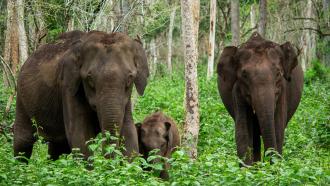Photo: Siddharth Kankaria / Research Matters
Organisms with single cell mostly reproduce asexually through cell division by splitting into two or more cells and yeasts are no exception. They divide by fission or budding, a process where new daughter cells ‘bud’ off after receiving half of the nucleus and some cytoplasm from the mother cell. A recent collaborative study by scientists at the Jawaharlal Nehru Centre for Advanced Scientific Research (JNCASR), the Indian Association for the Cultivation of Science (IACS), the Tata Memorial Centre, Advanced Centre for Treatment Research and Education in Cancer, Navi Mumbai and the Indian Institute of Technology – Bombay, has now thrown some insights into the mechanism of nuclear division in yeasts. The study, led by Prof. Kaustuv Sanyal from JNCASR and Prof. Raja Paul from IACS, has succeeded in generating a computational model that accurately predicts the nuclear division dynamics in two types of yeasts belonging to two phyla - Ascomycota and Basidiomycota.
Mitosis is a part of the cell division cycle where the duplicated and condensed chromosomes align at a plane inside the cell and are then segregated. This segregation process requires the formation of an apparatus known as spindle, which is a collection of microtubules (MTs). Microtubules are filamentous elements made by assembling units of proteins called tubulin. During the segregation of chromosomes, these microtubules provide the required force to pull the chromosomes apart. Some slide on one another through the help of some motor proteins providing the pushing force. As a result of these forces, the duplicated chromosomes break from each, forming two nuclei.
In this study, the researchers have examined and explained the differences in nuclear movements observed in Ascomycota and Basidiomycota. Though both type of yeasts reproduce by budding, the researchers observed that there is a difference as to “where” exactly the nucleus divides. In Ascomycota, the nucleus divides in the mother cell and one of them later passes into the newly budded daughter cell. But in Basidiomycota, the entire nucleus sneaks into the daughter cell even before the division. When it divides, it is the mother cell that receives a nucleus from the daughter.
Using these observational data, the researchers have built a computational model that can simulate the nuclear movement dynamics when fed with phylum specific parameters. The model considers parameters like the number of cytoplasmic MTs, viscosity of the cytoplasm, size of the nucleus, etc. from experimental measurements. This generic model is then modified into a phylum-specific model by incorporating specific parameters of the phyla. “In this study, we came up with a minimalistic model which is surprisingly robust and we attempted to answer a few fundamental questions – this worked!”, says Prof. Raja Paul.
The researchers found that this model was accurately able to predict the differences in nuclear dynamics and mitotic divisions for different phyla of yeasts and these predictions were validated by experimental measurements carried out in Prof. Sanyal’s lab.During experiments, the researchers observed that the spindle was positioned close to the neck of the bud in both types of yeasts, suggesting that the site of nuclear division is conserved with respect to the site of cell division. The computer model accurately predicted the same locations for the nucleus in both the cells and also that at least 8 cytoplasmic MTs (cMTs are cytoplasmic microtubules which contact a peripheral region in the cell called as cell cortex) are required to explain the movement of the nucleus into the daughter cell in Basidiomycota, before it divides. Experimental measurements showed that the average number of cMTs in this type were indeed 9.
The model also successfully predicted the observed deviations when tested with yeasts that were treated with drugs that disassemble MTs. In this case, the spindle formed is smaller and incorrectly oriented with respect to the mother-daughter cell axis, resulting in unsuccessful nuclear division. In addition to predictions closely matching experimental measurements, the model was found to reflect the mitotic events accurately and robustly.
The newly developed computational model is the first to be covering such a large fraction of mitosis in yeast. It can be used to study major events in mitosis including nuclear migration, spindle orientation and spindle length dynamics in a quantitative manner. The team has also built a number of similar predictive models to understand spindle assembly during mitosis, erroneous cell division that can trigger cancer, assembly of cellular organelles, tumour induced angiogenesis, etc. for higher eukaryotes and mammalian cells that can deliver potential clinical benefits.“Moreover, two organisms used in this study, Candida albicans and Cryptococcus neformans, are human pathogens. Anti-fungal drug resistance is growing at an alarmingly high rate. Finding out key differences in the process of cell division in these pathogens and humans may pave the way of developing specific anti-fungal drugs in future”, says Prof. Sanyal.
This study also demonstrates a successful outcome of collaboration between theoretical biologists at IACS and experimentalists at JNCASR. “It is a win- win situation for both the groups provided relevant problems are considered which not only improve scientific knowledge-base and trigger inquisitiveness among the community, but also promise to decipher pathophysiological conditions”, signs off Prof. Paul.






